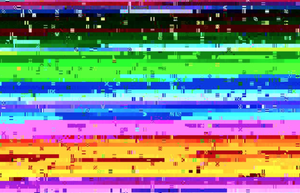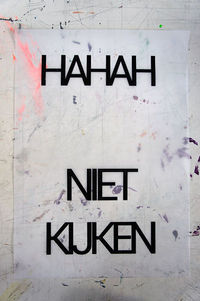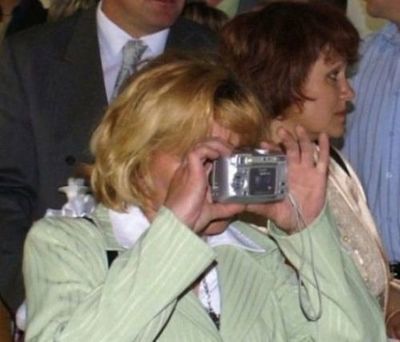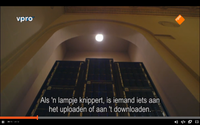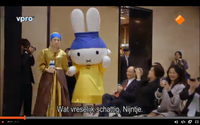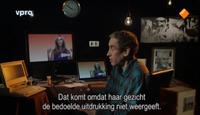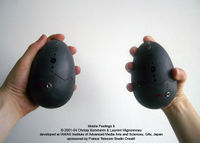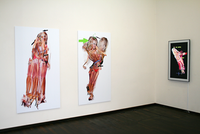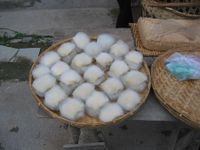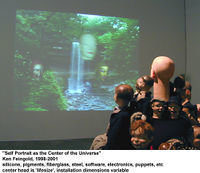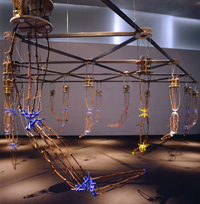User:Thelma
Thelma Boateng [[1]]
‘Tools & Tech’ workshop assignments:
• OV-Chipcard Diaries: It was nice to get to know people by this manner and to get to learn the Arduino basics. Check the movie I've made for Ciska here >>[2]
• Knitting: There went something wrong with transferring my pattern to the knitting machine. So while knitting I found out that I had the same pattern as Joeke, oops.. but that’s not a problem, now I know how to do it.
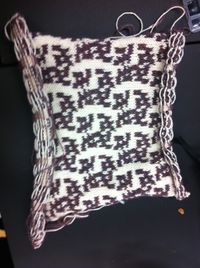 (Joeke's pattern I've knitted)
(Joeke's pattern I've knitted)
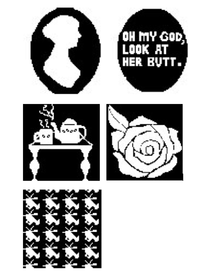 The patterns I designed in Photoshop for the workshop
The patterns I designed in Photoshop for the workshop
• Silkscreen: worked together with Joeke and Robin. We designed a random tekst: HAHAH, NIET KIJKEN. Double; you want attention by wearing this, but people are not allowed to look at it. How??
• Movement: worked together with Lizet. We want to design a cap with a moving flap.
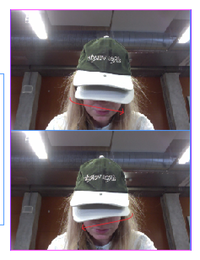 Lizet with the moving cap which is not moving yet
Lizet with the moving cap which is not moving yet
Additional presentations: 1. The dangers of sharing: collaboration with Robin
2. Performance: how did mobile devices change our everyday life?: a collaboration with Leslie, Jessica and Robin.
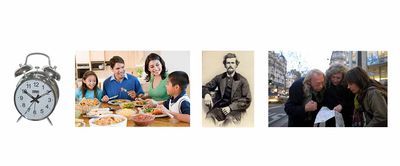 Unfortunately we don't have pictures of the performance anymore,
this was the background picture of our performance.
Unfortunately we don't have pictures of the performance anymore,
this was the background picture of our performance.
Contents
- 1 How did contemporary technology influenced our body, mind, behavior and our network?
- 1.1 #Fake for real
- 1.2 #20 crazy things people do to get wi-fi connection:
- 1.3 #Tegenlicht documentary: ‘’Digitaal geheugenverlies’’ (Digital amnesia)
- 1.4 #Tegenlicht documentary: ‘’‘’Hoe echt is echt?’’ (How real is real?)
- 1.5 #Tegenlicht documentary: ‘’Herovering van het nu’’ (Reconquest of the present)
- 1.6 #Tamiko Tiel
- 1.7 #Monica Studer and Christoph van den Berg
- 1.8 #Ed Atkins
- 1.9 #Christa Sommerer & Laurent Mignonneau
- 1.10 #Mark Napier
- 1.11 #David Rokeby
- 1.12 #Ken Feingold
- 1.13 #Ken Rinaldo
How did contemporary technology influenced our body, mind, behavior and our network?
#Fake for real
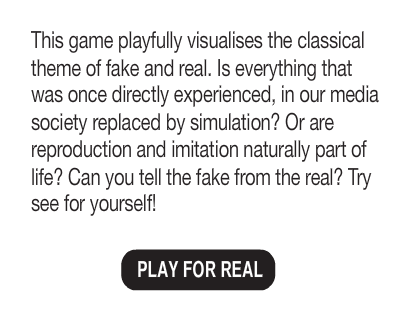 Play the game > [[3]]
Play the game > [[3]]
#20 crazy things people do to get wi-fi connection:
In their quest to get Wi-Fi Internet connectivity, people have done some pretty desperate things over the years. I've selected a few:
- 4. "Driven to the local coffee shop and purchased a muffin to use their wireless."
- 7. "I have plugged my laptop into a hospital Ethernet line because the wireless was down."
- 9. "Plugged into the back of a cash register."
- 11. "Turned someone's TV antenna into a wireless internet antenna."
- 12. "Logged into hotel conference rooms to get the connection for free."
- 14. "Plugged into electricity from the city of Seattle that was on a pole on the sidewalk, but only for a few minutes."
- 15. "Held my laptop out a window to get the Wi-Fi next door so I could send an important email."
- 16. "Sat outside an airport for 4 hours so I could use the free wireless across the street."
- 18. "Moved throughout my home because of connection problems, I found myself sitting in a ducky chair in my toddler's room because that is where I got the best connection."
Check the rest out here: [4]
#Tegenlicht documentary: ‘’Digitaal geheugenverlies’’ (Digital amnesia)
Our lives are continuously captured for ‘’later’’.. but is it? Digital files are vulnerable. We think that internet is a library, but it isn’t. It’s worrying that libraries are slowly whittled. (what happens with all those books?) While internet is also not permanent… so much of the web is already gone; they’re changing and coming all the time.
#Tegenlicht documentary: ‘’‘’Hoe echt is echt?’’ (How real is real?)
What happens with the truth? Experiences you’ve gained cause of the media also mean something in the physical world. What’s real and what’s unreal in this digital era? ( is real = good, fake = bad, because you’re being cheated ??) But in the east of the world copy and original are experienced differently; Asia embraces digital technology way faster. Actually, we are the grumbling Westerners. We’re pretty naïve about what we call ‘real’.
#Tegenlicht documentary: ‘’Herovering van het nu’’ (Reconquest of the present)
We’re always ‘’ON’’ (line) and we’re continuously disturbed. Most of the times; we aren’t where we are. All technologies don’t help us to become more human, but to keep the dying market alive. Not to keep you and me in contact. ‘’They’’ are always between every interaction.
When I talk to someone, no one earns money with it. But when I talk trough my phone with a person, someone does.
We’re immigrants in the present. Everything is changing so fast. (analog and digital clock; we don’t follow the second-hand (?) anymore.. not moving through time; but from minute to minute) It becomes a serie of choices which we make; you click on this or you click on that. ON/OF? YES/NO? Or you just don’t click on it… [6]
#Tamiko Tiel
Tamiko Thiel is a visual artist exploring the interplay of place, space, the body and cultural identity.
To commemorate this event Tamiko has created "Carnation Rain", an augmented reality (AR) artwork of an animated rain of carnations, placed via GPS in Largo do Carmo.
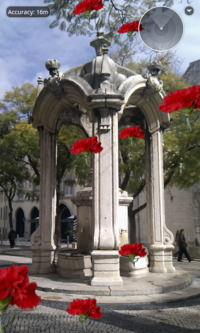
#Monica Studer and Christoph van den Berg
They've designed an virtual hotel. 3D animation is combined with interactive internet-art. I love this idea, it’s so funny. You can just relax on a vacation in the Alpes, while you’re at home and you can just do you’re work. You can book a room for your virtual stay, amidst a refreshing computer landscape. You will neither be disturbed by noise of cars or by Lloret-de-Mar-tourists in the solitude of the mountains! You can also buy postcards and send it to your loved ones. It’s perfect, because we don’t have time anymore for a ‘’real’’ trip, right? [8]
#Ed Atkins
Atkins’s work draws attention to the way in which we perceive, communicate and filter information. His videos combine layered images with incomplete or interrupted excerpts of singing, speech, subtitles and handwriting. Working with a specialist in computer generated animation, Atkins exploits the hyperreal surfaces produced by new software systems to create complex, nightmarish environments populated by virtual characters, avatars of ambiguous provenance and desires. [9]
#Christa Sommerer & Laurent Mignonneau
‘’Mobile Feelings’’ is an artistic project that explores the ambivalence of sharing personal information with an anonymous audience. Instead of communication via voice or images to people we know, "Mobile Feelings" lets people communicate with strangers through virtual touch and body sensations including smell and sweat using specially designed mobile phones.
#Mark Napier
PAM is a venus born from and made for the digital landscape. Pam Anderson - the most imaged woman on the web, becomes the subject matter for a reverse-cubist portrait. A woman re-formed from hundreds of fragmented images found online. PAM began as generative software that produced a moving figure created from fragmented body parts.
#David Rokeby
Quaver (2010) an interactive video installation, is a playful confrontation between language and the body... an exploration of voice as the place where the alphabet most directly meets flesh. In the gallery space, the visitor is confronted with a large video projection and a microphone on a stand. Initially, the screen shows a swarm of three-dimensional letters floating around in an indeterminate deep red space Each letter of the alphabet is wrapped in images of the artist's skin, making them resemble internal organs, while paradoxically retaining their sharp Helvetica edges. The overall experience is as though the viewer is floating inside their own flexing vocal tract, their own throat.
#Ken Feingold
The self-portrait animatronic head has open-ended, improvisational conversations with its alter ego, a virtual head that appears as the central figure in the projection. Like If/Then, the conversations between these two figures do not include the audience; rather, they interact only with each other.
#Ken Rinaldo
Autopoiesis is an artificial life robotic series of fifteen musical and robotic sculptures that interact with the public and modify their behaviors based on the both the presences of the participants in the exhibition and the communication between each separate sculpture. This series of robotic sculptures talk with each other through a hardwired network and audible telephone tones, which are a musical language for the group. Autopoiesis is "self making", a characteristic of all living systems.
